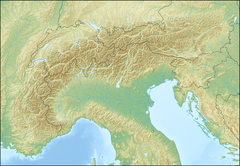Ötzi
The "Scots" that wis uised in this airticle wis written bi a body that haesna a guid grip on the leid. Please mak this airticle mair better gin ye can. (Januar 2021) |
Ötzi (German pronunciation: [ˈœtsi] (![]() listen); cried the Iceman, the Similaun Man, the Man frae Hauslabjoch, the Tyrolean Iceman, an the Hauslabjoch mummy an aw) is a nickname gien tae the well-preserved naitural mummy o a man wha leeved around 3,300 BCE, mair precisely atween 3359 an 3105 BCE, wi a 66 percent chance that he dee'd atween 3239 an 3105 BCE.[2] The mummy wis foond in September 1991 in the Ötztal Alps, hence the nickname "Ötzi", near Similaun moontain an Hauslabjoch on the border atween Austrick an Italy.[3] He is Europe's auldest kent naitural human mummy, an haes offered an unprecedentit view o Chalcolithic Europeans. His bouk an belangins are displayed in the Sooth Tyrol Museum o Airchaeology in Bolzano, Sooth Tyrol, Italy.
listen); cried the Iceman, the Similaun Man, the Man frae Hauslabjoch, the Tyrolean Iceman, an the Hauslabjoch mummy an aw) is a nickname gien tae the well-preserved naitural mummy o a man wha leeved around 3,300 BCE, mair precisely atween 3359 an 3105 BCE, wi a 66 percent chance that he dee'd atween 3239 an 3105 BCE.[2] The mummy wis foond in September 1991 in the Ötztal Alps, hence the nickname "Ötzi", near Similaun moontain an Hauslabjoch on the border atween Austrick an Italy.[3] He is Europe's auldest kent naitural human mummy, an haes offered an unprecedentit view o Chalcolithic Europeans. His bouk an belangins are displayed in the Sooth Tyrol Museum o Airchaeology in Bolzano, Sooth Tyrol, Italy.
Ötzi | |
|---|---|
 | |
| Born | c. 3300 BCE near the present veelage o Feldthurns (Velturno), north o Bolzano, Italy |
| Dee'd | c. 3345 BCE (aged about 45) Ötztal Alps, near Hauslabjoch on the border between Austrick an Italy |
Cause o daith | Exsanguination due tae arrae woond on his shouder[1] |
| Ither names | Ötzi the Iceman Similaun Man "Frozen Fritz" Man frae Hauslabjoch Hauslabjoch mummy Frozen Man |
| Kent for | Auldest naitural mummy o a Chalcolithic (Copper Age) European man |
| Hicht | 1.65 m (5 ft 5 in) |
| Wicht | 50 kg (110 lb; 7.9 st) (when aleeve) |
| Wabsteid | |
| South Tyrol Museum of Archaeology | |
References
eedit- ↑ "NOVA - Iceman Murder Mystery". pbs.org.
- ↑ Bonani, Georges; Ivy, Susan D.; et al. (1994). "AMS 14
C
Age Determination of Tissue, Bone and Grass Samples from the Ötzal Ice Man" (PDF). Radiocarbon. The Department of Geosciences, The University of Arizona. 36 (2): 247–250. doi:10.1017/s0033822200040534. Retrieved 4 Februar 2016. - ↑ James Neill (27 October 2004), Otzi, the 5,300 Year Old Iceman from the Alps: Pictures & Information, archived frae the original on 12 Mairch 2007, retrieved 8 Mairch 2007
| This airticle is a stub. Ye can help Wikipaedia bi expandin it. |
